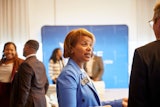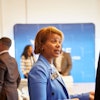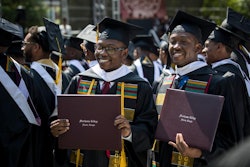There was great anticipation when The Smithsonian National Museum of African American History and Culture officially opened its doors a year ago.
The nation looked on as the 99-year old daughter of a slave rang the opening bell, while the first African-American president and First Lady, Barack and Michelle Obama, stood at her side. This historic visual was a moment for many to finally recognize the important value of history and its permanence and resonance to the present.
 Dr. Lonnie Bunch is the director of The Smithsonian National Museum of African American History and Culture.
Dr. Lonnie Bunch is the director of The Smithsonian National Museum of African American History and Culture.Located on the National Mall in the nation’s capital, the NMAAHC encapsulates the powerful narrative of African-Americans and their significant journey to and within the United States.
Appropriately known as “A People’s Journey: A Nation’s Story”, NMAAHC takes up 400,000 square feet and has seven levels. In its first year, the museum has set new records for the average length of visits, which is four to six hours, and has the largest number of museum charter members.
“What’s clear is that the museum has struck a nerve,” said Dr. Lonnie Bunch, the director of NMAAHC. “It’s become an important symbol, an important metaphor, an important pilgrimage site. We’re quite humbled by the way the public and the critical public has embraced the museum.”
As the 19th member of the Smithsonian Institution, the NMAAHC has attracted more than 2.1 million visitors and has 36,000 artifacts, where only 10 percent are currently on display, said Dr. Leslie Fenwick, dean emerita and professor of the Howard University School of Education. Fenwick is also a member of the NMAAHC Scholarly Advisory Committee, founded by the late historian, Dr. John Hope Franklin.
The museum’s exhibits tell many stories of African-American history, with much focus on education. Shedding light on African-American history in academia reveals how the founding of historically Black colleges and universities initiated great change, including solutions to freedom, even as Blacks fought against a socially oppressive agenda.
“You can’t tell the story of the African-American experience without talking about HBCUs,” said Bunch in an interview with Diverse.
The connection between the NMAAHC and the HBCU community is shared through the continuity of the struggles of HBCUs and their contributions to historic events, as well as, artifacts that schools have donated or loaned to the museum.
“Virtually every activity that the museum represents, any exhibits, has a connection with the HBCU community,” said Dr. H. Patrick Swygert, a founding member of the NMAAHC Museum Council, and president emeritus of Howard University. “As an example, on one of the levels there is an electronic table where you can digitally dial up moments in Civil Rights History. And in so many of those moments you’ll see sit-ins in Greensboro, North Carolina, where young African-Americans sought access to Woolworth’s, or Freedom Riders where you had young African-American students from HBCUs who participated in voter registration. They’re all represented in the museum.”
Spreading the story of HBCUs throughout the museum is to ensure that visitors understand the history, importance and continuing resonance of these institutions, said Bunch.
“There are exhibits that look at the role of education, in terms of how it creates a counter-narrative to the way African-Americans were depicted in the late 19th- early 20th century,” he said “There are exhibitions that explore the role of HBCUs in education, in science and law. There are exhibitions that explore the culture of the HBCU- the role of stepping, the role of fraternities and sororities.”
The relationship between the NMAAHC and HBCUs also extends to the acquisition of pieces from HBCUs. Historically and presently, African-American artists have viewed historically Black colleges as homes and centers of appreciation for their work. Hampton University, Florida A&M University, Southern University, Spelman College and Clark-Atlanta University, are among many HBCUs that have the work of African-American artists on display and within their archives.
“Black artists were nourished at HBCUs,” said Fenwick. “The interesting thing about that is, here you have HBCUs founded in church basements under austere racial circumstances and yet, there was a presence of mind to protect cultural products and artifacts.”
Many of the exhibited pieces within the NMAAHC art gallery are the finished products of HBCU graduates and faculty members, said Swygert.
The museum has work from Aaron Douglas, the founder of Fisk University’s Art department, as well as, David Driskell, a Howard University alumnus, who taught at both Howard and Fisk.
Looking to the future, Bunch said the NMAAHC will continue to build upon the relationships, excitement and the trust that the museum has ignited over the past year.
“We will continue to do educational programs to service schools, both locally and nationally,” said Bunch. “We’ll continue to do public programs that will run the gamut, programs that celebrate cultural creativity—music and the arts—to programs that will wrestle with the challenge of the confederate statues, for example,” he said.
“We’re also going to work on some exhibitions. One of the most important exhibitions we’re going to be doing is an exhibition that looks at The Poor People’s Campaign, which is Resurrection City, which was here in Washington D.C.,” he added. “We’re also looking at what are the stories, what are the exhibitions we should do that will enrich what the museum already does, but also will help the public understand more deeply some of the history .”


















